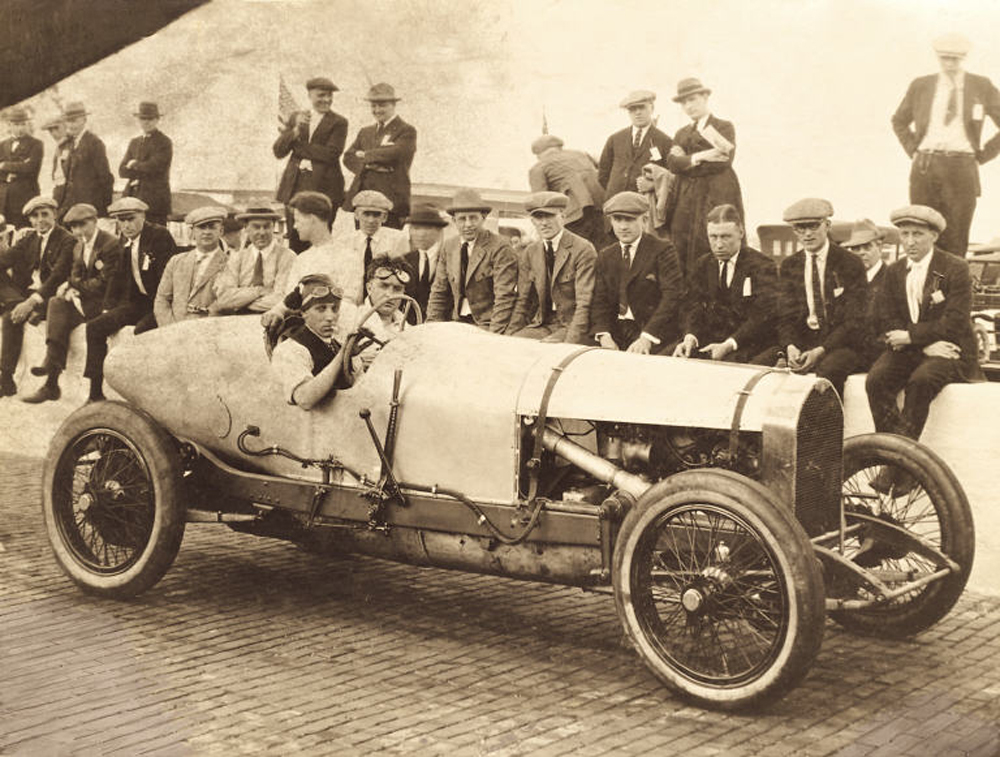
- 1921 Bentley 3-Litre was developed from 1919 and made available to customers’ coachbuilders from 1921 to 1929.
- The 3 Litre Speed was the first performance-focused Bentley’s model range.
In August 1921 the first production Bentley (the 3 Litre AX 3827 model) was sold to Noel van Raalte – a well-known, wealthy race car driver. Five of these were made per week and the unique British machines were heavily engineered to meet the demands of racing.
Although the 3 Litre was designed for the track, owners began to fit heavy all-weather bodies which meant some cars weighed a 1.5 tonnes. Bentley imposed strict conditions on the chassis of the car, which had to be taken to for approval at Cricklewood before the 5 year guarantee was granted.
It could be purchased with either a short or long chassis, with the longer framework proving more popular with customers, outnumbering the shorter model by almost five to one.
Famous automotive illustrator, F. Gordon Crosby, drew an impression of the 3 Litre before it was finished, with a distinctive round radiator shape and a coloured, winged Bentley badge. Although not required, it was customary to specify a 3 Litre with a Bentley badge in a particular colour, with blue, green, yellow, maroon or red badges available.
From 1924 -1929 the Speed model was introduced, which was a development of a special TT Replica. In total, 71 of these were produced with the additional features of four wheel brakes and twin SU carburettors.

The Bentley 3 Litre won Le Mans in 1924 driven by John Francis Duff and Frank Clement.
In 1927 the famous ‘White House’ crash (which involved all three of the widely tipped Bentley team’s entries) caused the retirement of two of the cars. Despite this setback, Old Number Seven, driven by Sidney Charles Houghton Davis and John Dudley Benjafield, won the race against all odds. Old Number Seven had to be partially dismantled to get it through the doorway and upstairs for a celebratory dinner at The Savoy.
- Dates Produced; 1921-1929
- Number Built; 194 short wheelbase; 765 long wheelbase; 959 total
- Price New; Sold in 1919 for £750 ($953.00 USD)
- Engine; 3 Litre, 4 cyl, 4-valves, hollow overhead camshaft gear-driven from front. Cast-iron non-detachable cylinder head, Cast iron cylinders. Aluminium crankcase
- Transmission; 4-speed gearbox, Ferodo cone clutch, right hand change
- Chassis; With bodywork 28cwt (1422.4kg) to 35cwt (1778kg).
- Dimensions; Wheelbase (short) 117 in (298 cm); (long) 130 in (330 cm); track 56 in (142cm); length (short) 159 in (404 cm), (long) 172 in (438 cm); width 68 in (174 cm); ground clearance 7.2 in (18.5 cm)
- Performance; Maximum speed of 75mph (120.4kph). 0-60mph in 40sec

The Bentley 3 Litre
The 3 Litre represents W.O. Bentley’s original vision of ‘a fast car, a good car, the best in its class’ brought to life. It stayed in production from 1921 to 1929 and won countless races, including the 24 Hours of Le Mans in 1924 and 1927. Production of the 3 Litre was slow at first, but Bentley’s order books were soon packed with the names of wealthy and aristocratic clients, including Prince George (later the Duke of Kent), the Prince of Wales (Edward VIII) and the Duke of York, later King George VI. The 3 Litre remained in production until 1929, and models included the standard wheelbase Blue Label (for which Bentley literature claimed “with four passengers it is guaranteed the machine will lap Brooklands at 75mph”), Red Label Speed and 100mph Green Label models. It remained the mainstay of the Bentley range in production volumes until the introduction of the 4½ Litre. 1,622 examples of the 3 Litre were built.
The Speed Model
IN 1924, Bentley launched the 3 Litre Speed Model, with a power increase from 70 to 80 bhp achieved by increasing the engine’s compression ratio. A shorter wheelbase than the standard 3 Litre was used, at 9’ 9.5”.

YN9097
Bentley’s own 3 Litre Speed was built in 1926 and delivered to renowned Bentley race Forrest Lycett. Fully restored and with matching numbers throughout, YN9097 is a perfect example of the quality, speed and athleticism of the 3 Litre.
| Date Produced | 1921-1929, this example 1926 |
| Chassis/engine no. | PH1454 / PH1454 |
| Number Built | 1,622 total of which 513 were Speeds |
| Body | Open tourer; 2-doors, 4-seats, Vanden Plas body |
| Engine | Straight-4. 2,996 cc, four valves per cylinder, twin spark, overhead camshaft with bevel drive. Cast iron monobloc, twin ‘Sloper’ SU carburettors. |
| Power | 80 bhp @ 3500 rpm |
| Transmission | Four-speed manual |
| Chassis | Pressed steel frame, 117.5 in chassis |
| Performance | Maximum speed 90 mph (145 km/h) |




You must be logged in to post a comment.